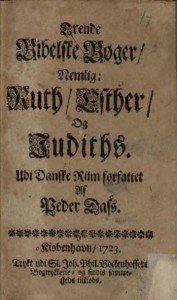Heritage of Biblical Exegesis
Despite the absence of direct literary influence, and all the fundamental historical changes between second Temple and rabbinic Judaism, certainly prominent and basic to this continuity in all the aspects of Judaism to be discussed below–legal, theological, eschatological–is the area of biblical exegesis. After all, biblical interpretation stands as the basis for Judaism throughout its history and all its manifestations. But even here, as we will see, the issues are complex.
One area of almost complete continuity is that of translation of the Bible. Here we deal with two issues, the Greek translation (LXX) and the Aramaic Targumim.
Regarding the Greek, one might gather from the tannaitic parallel to the account of the 72 elders in the letter of Aristeas that the rabbis, on the one hand, saw the translation as a tragic step in the Hellenization of the Jews, but at the same time approved of the actual translation, at least of the modifications supposedly made by the elders for polemical reasons. On the other hand, scholarly investigation (cf. Tov) of these variants shows that the account reflects no actual familiarity with the Septuagint which, like the other Greek Jewish literature, was apparently lost to the rabbinic Jewish community by this time. This is despite the fact that after the Septuagint additional Jewish translations were created or adapted to bring the Greek closer to the Masoretic Text that was now the standard for Jews. Clearly, the Greek Bible simply became identified with Christianity, despite the use of the Septuagint by Josephus and/or his assistants.
Regarding Aramaic the situation is more complex. Although the small fragment of Targum Leviticus found at Qumran has exegetical parallels with the later Leviticus Targumim and rabbinic exegesis, the actual Targum text from Qumran was not taken up by the rabbis. This is more apparent from examination of the Job Targum, the other Targum text preserved (very substantially) at Qumran. Here we see that, like the Targum Job preserved by the rabbinic community, this is a very literal translation. Tannaitic tradition mentions that both Rabbam Gamliel I and II buried Job Targums because of the belief that translation was part of the oral law that was forbidden to be written. No mention of sectarian prominence appears, and in any case there is nothing at all sectarian about the pre-Qumran Job Targum. Yet there is no literary relationship between these two Job Targums. The second Temple version apparently fell into disuse and was replaced by a later and much younger one. All in all, then, rabbinic tradition continued the pattern of translation, but initially rejected it in the form of a written text. All pre-70 C.E. Targumim were lost and later texts, composed or at least recorded after the rabbis loosened up their prohibition of writing the oral law, replaced the old, lost ones.
Another area to look at is in the vast library of second Temple books containing non-literal exegesis of the Bible of the type usually termed rewritten Bible or expansions on the biblical text. In some of the exegetical presumptions of these texts, they seem similar to rabbinic aggadah. Here we need to distinguish form from content. Whereas the second Temple texts of the pseudepigrapha and numerous Dead Sea Scrolls allow the authors to invade the actual biblical texts, as is done in the Genesis Apocryphon, Jubilees and for halakhah in the Temple Scroll, it seems that the barrier between written and oral texts for the rabbis meant that such books were totally forbidden.
The rabbis seem to maintain this distinction strictly, even with the gradual abeyance of the prohibition of writing the oral law, so not a single literary contact can be traced between these texts and rabbinic literature. However, where we also see parallels is in the examination of the specific units of interpretation and sometimes in the actual content. In general terms, we can see specific passages that use exegetical techniques similar to those of the rabbis later on. But here what is striking is that often in these examples the interpretations of the rabbis are different. At times, there are common interpretations and these were no doubt part of the traditions inherited by the rabbis from second Temple times. But often rabbinic tradition directly contradicts such interpretations found in earlier books.
One type of scrolls exegesis with no real resonance in rabbinic literature is the Pesher. This form of contemporizing exegesis argues for a two-step process of prophecy and assumes that the earlier prophets did not really speak to their own times but to second Temple historical circumstances. Despite some homiletical flourishes here or there, this form of exegesis and most of its content has little relevance in rabbinic literature.


Leave a Reply